Why animals talk
Dr Arik Kershenbaum is
decoding animal communication.

Deep in the jungle, voices speak. No-one has heard these voices for decades. Many assumed they were lost forever.
Trekking through the mountains of northern Vietnam, you can hear the voices for a long time before spying their source.
Call of the Cao Vit Gibbon
One thing strikes you, as you listen to the hoots and howls of the voices. They are clearly intentional. They are a mark of an intelligence separate from your own, lurking in the canopy above your head, swinging with laughable ease between the trees, making a mockery of your harsh journey.
“It is an incredibly haunting, beautiful song,” says Dr Arik Kershenbaum, Cambridge zoologist, Girton Fellow, and pursuer of the Cao Vit Gibbon. “For me, it brings home how truly rich the communication of other species is.”
When animals talk, Kershenbaum is all ears. By listening to animals in their natural habitats, he teases apart the messages they send one another, and reveals the driving forces behind their communication. His work challenges our preconceptions about what animals are capable of, while also reaffirming what makes humans truly unique.
Primates like the Cao Vit Gibbon are special. A perfect storm of evolutionary conditions has made them both intelligent and communicative. They feed on fruit trees in the jungle: a scarce and capricious resource. They have to remember when a given fruit is ripe, where it is, and compete with other animals to get there first. In order to do this, they work as a team, giving information to each other about food sources and their own whereabouts. By cooperating in this way, their hoots and howls have become richly layered and nuanced.
Kershenbaum studies wild species on their own terms. He thinks their communication can tell us about how they came to be, and how they are different from us.
“We have to be careful not to think of animals having a language that we can translate. They are sending messages. But it’s not language. If we try to understand their communication as if it were human language, all we’re doing is imposing our own nature on them.”
Marking the territory
In a careful distinction, Kershenbaum specialises in animal communication, not ‘animal language’.
This linguistic landscape has been scouted, criticised and fought over, like the murkier regions of a dense forest. Linguists disagree on how distinct the boundary should be between ‘communication’ and ‘language’.
Arik marks his own territory: “All animals communicate. If you move around, you need some way to send signals to others of your species. You also need the ability to sense your environment and pick up all kinds of signals.
“What we call ‘language’ in humans is very different to what animals do. Humans can communicate an unlimited number of concepts. There’s no other animal we know of that does that.
“There may be other species out there that have the capacity to do what we do, but they don’t seem to be doing it in the wild.”
Why not? Because they don’t need to.
Animals are adapted to survive in ecological niches. For a given trait to endure, it needs to help them survive. Arik thinks we should be careful in assuming that traits which have helped humans would be helpful to other animals. They are doing just fine without language.
Enlightenment philosophers drove a wedge between humans and other animals. They preserved our uniqueness by denying similarities between us and other creatures. Descartes labelled animals ‘automata’ - mindless machines playing out simple routines, running on clockwork instincts, with no inner lives to speak of.
Until the 20th century, scientists mainly studied animal behaviour in reductionist settings. They created sterile mazes and encouraged rats to complete them. They placed wild animals in controlled environments and picked apart their workings.
For Kershenbaum, this approach ignores the full range of animal behaviour, and distorts our assessment of their character.
“It is the complexity of the environment around biological creatures that makes them act the way they do. By not studying how animals exist in the wild, we ignored their context: a 4-billion-year interaction between species and environment.”
What can animals in the wild tell us about their communication? There’s only one way to find out.
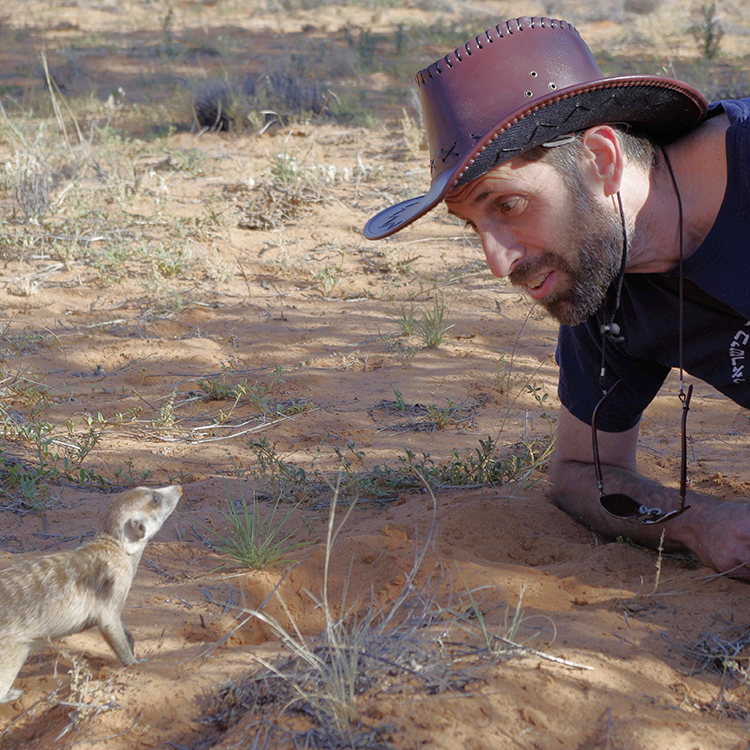
Arik with a meerkat
Arik with a meerkat
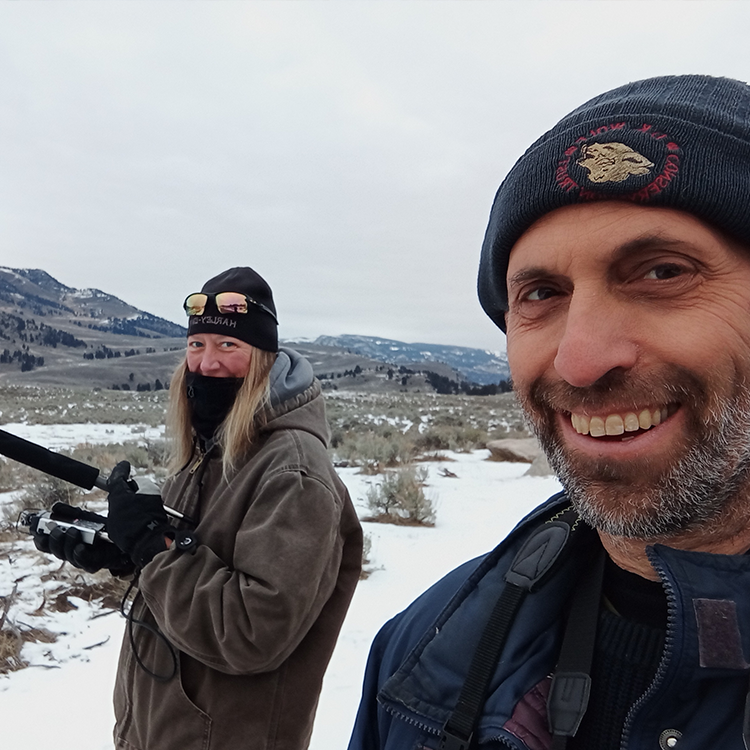
Arik with a colleague in the snowy wilds
Arik with a colleague in the snowy wilds
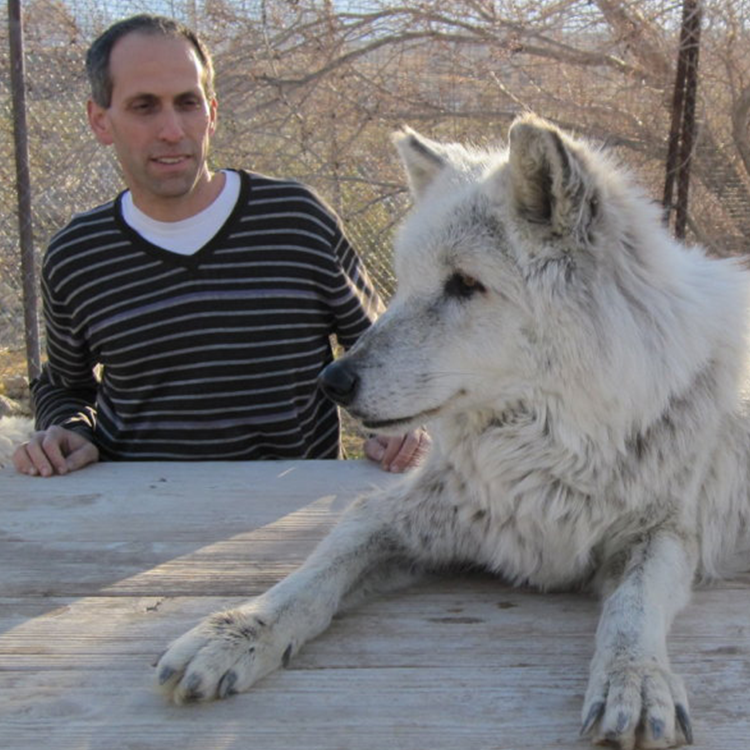
Arik with a wolf
Arik with a wolf
Into the wild
In the water with dolphins, you are out of your element. And they know it.
“Dolphins are clearly intelligent,” Kershenbaum says, recalling his time swimming with them. “They’re very interested in you. They’re aware that in this underwater environment, you’re pathetic. You can barely swim, compared to their abilities.”
Five dolphin whistles
Dolphins are the only animals we know of that give each other names. They play games with one another, like ‘catch the fish’ and ‘tag, you’re it’. But communicating underwater is a steep challenge. In such a noisy environment, transmitting information over longer distances is fraught with difficulty. With a series of clicks, dolphins can ‘see’ in sonar - an ability known as echolocation. At close range, they can chat comfortably, but have to adapt the sounds they make when sending messages over long distances.
A surprising parallel can be found in another species Kershenbaum studies: wolves. Wolves share the dolphins’ problem of reliably transferring information in a confusing environment.
“Dolphins and wolves have a lot in common. Long-range communication has some physical constraints: a lot of nuanced information is lost when you send an acoustic signal over long distances. That’s the same if you’re trying to communicate from one mountaintop to another, or trying to call your dolphin friend several leagues away.
“Both dolphins and wolves have evolved a much simpler, robust use of acoustics to overcome these physical restraints on long-range communication.”
This is why wolves howl. Howls are adapted to travel. They remain detectable and distinct over long distances. As far as Kershenbaum can tell, howls fulfil at least three different roles: marking out territory, keeping in touch with other pack members, and, adorably, satisfying the animal's love of howling.
Eastern Timber Grey Wolf howl
Whether this kind of long-range communication lacks the subtlety and complexity required for what we call language is contentious. Ian Roberts, Professor of Theoretical Linguistics at the Faculty of Modern and Medieval Languages and Linguistics, thinks that the systems Kershenbaum describes are limited.
“Human languages all rely on two separate systems,” Roberts says. “The first combines meaningless sounds into meaningful sentences. The second combines meaningful words into potentially unlimited sentences. The communication systems Arik describes don’t seem to work in this way.”
Kershenbaum is less convinced that all potential languages would need words and sentences. He remains open-minded on animals’ ability to communicate information, even if long-range methods demand more basic messages. There does seem to be more information transmitted in the short-range communication of animals, even if we can’t call it ‘language’.
Dolphins and wolves have this kind of short-range communication (whistles, barks and growls), but studying this poses a greater challenge. Getting close enough to eavesdrop on a wolf pack isn’t usually possible. One animal that Kershenbaum has got closer to is the hyrax.
Hyraxes are small, rotund, furry mammals, who live in large groups. Their songs are long and loud. As Kershenbaum found out, their calls have specific meanings.
“Hyraxes keep guard. One of them keeps a lookout for predators, and calls out when one is sighted. Depending on the type of call, the group can come together to mob this potential predator.
“In a particular case, I was doing some research close to a hyrax colony. I played a recording of a hyrax distress call, and they all came running at me. There were about 20, and they were very threatening.
Call of the hyrax
“This just illustrates that communication in the social context plays an adaptive role. It's really important to be able to say ‘here's a predator, come and help me’, and that needs to be a different call from ‘I see a predator, run and hide’. It becomes very clear that hyrax messages have different meanings.”
More widely, the problem of understanding meaning in animal communication is daunting and controversial.
“Animals convey a lot of information in their communication, but it’s probably encoded very differently to how we do things. They almost certainly do not use an equivalent of words, for example. Before you can hope to understand what they’re saying, you have to understand where the information is. These are not trivial problems.”
To help with this thorny information task, groups like Earth Species Project and Project CETI (the Cetacean Translation Initiative) are developing new algorithms and machine learning techniques. Kershenbaum acknowledges the benefits of these efforts, but sees problems with relying too heavily on data.
“If you hope to solve wider problems merely by looking at the data, and not the animals in the wild, you’re wrong. Some things can be done by data alone, but to understand meanings, you have to be able to see the behavioural context. It’s that context that drives all communication.”
“Pitching such efforts as ‘translation’ is misleading. There isn’t a word-to-word correlation between different animals’ communication. But we should use new technologies to figure out what information is in there - and that’s very valuable.”
"By not studying how animals exist in the wild, we ignored their context: a 4-billion-year interaction between species and environment.”
Dr Arik Kershenbaum
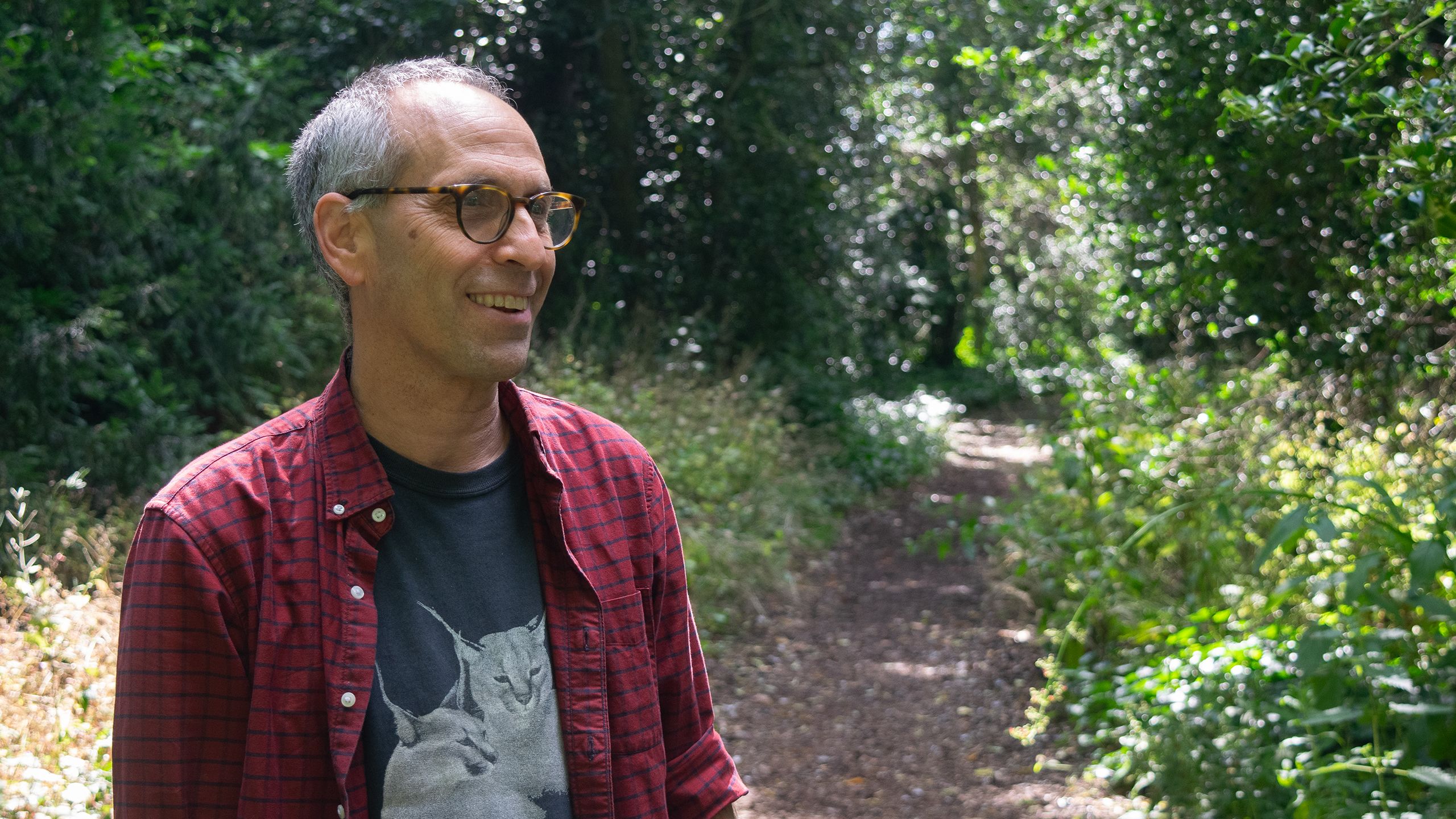

Our 'infinite faculty'
Life on this planet evolved horns, fur and flying far before it evolved human language. Why did it take 4 billion years?
There are no fossils of language. If evolution had taken a different path, we might never have evolved language at all. Tracking just how it happened is incredibly difficult. Two camps within linguistics have their own explanations.
The ‘one giant leap’ camp, spurred on by the ideas of Noam Chomsky, think that our syntactic mastery arrived in an evolutionary instant. A glorious moment, where perhaps even a single mutation endowed a lucky ape with the ‘infinite faculty’ of human language.
Conversely, the ‘step by step’ folk think that the biological endowments necessary for language evolved slowly over time, gradually cascading into the rich linguistic abilities we enjoy today.
Arik wants to emphasise the middle ground between the two camps.
“Neither of these approaches is likely to be completely right. What I don’t think anyone would deny is that our ancestors had the potential for language, in a way that other animals do not.
“6 million years ago, our ancestor species lived in the forest. In navigating a complex environment and cooperating in large groups, they were probably already developing a sophisticated social intelligence. That intelligence meant they had the potential to make use of language, should a helpful mutation come along.
“I think the most compelling narrative is that greater social intelligence led to greater communicative complexity, which then led to further social intelligence… a reinforcing evolutionary loop, going back and forth over a long time.”

Arik and colleagues in Vietnam
Arik and colleagues in Vietnam
So what abilities might underlie the successful evolution of language? Pointing to uniquely human abilities proves tougher than you might think.
“Perspective-taking is almost certainly required for language. All communication evolves because one animal wants to influence another, though that doesn't necessarily mean that the first animal understands that the other animal's behaviour will change, after receiving their message.
“That understanding appears to be rare in the animal kingdom. Humans have it. Chimpanzees and dolphins might have it.
“Abstraction - the ability to form representations - is also necessary for language, but doesn’t seem to be unique to humans. Abstraction and perspective-taking are part of a suite of ideas that came together and made the human language phenomenon.”
The ability to understand others, and project ourselves inside their heads, seems to be at the core of human language. But researchers are still debating precisely what allows us to make use of, in William von Humboldt’s words, ‘infinite use of finite means’.
In the future, Kershenbaum hopes to use his insights into animal communication to help with conservation. With a fuller understanding of what animals are saying, we could track them better in the wild, and monitor their behaviour.
Elsewhere, Cambridge researchers are leading the study of animal communication in surprising directions. Dr James Herbert-Read investigates how marine animals gather information from their environment, while researchers from many departments have debated how languages might sound on other planets.
Listening to what animals are saying has profound implications. In the haunting song of the gibbon and the yearning howl of the wolf, there are nuanced, intentional messages that we are only now beginning to decode. By paying careful attention, our appreciation of animal lives is deepened, while our own place in the natural world is both secured and granted further mystery. Arik’s work could tell us how other species think, where we came from, and why we talk.
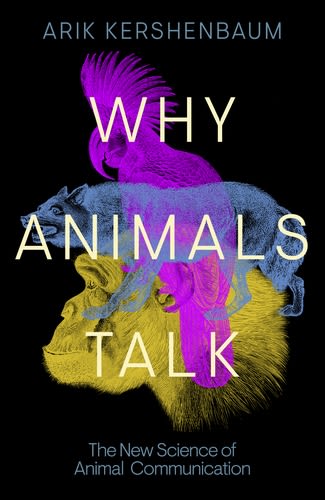
Front cover of 'Why Animals Talk'
Front cover of 'Why Animals Talk'
Why Animals Talk is available to buy.
Published on 28 August 2024
The text in this work is licensed under a Creative Commons Attribution-NonCommercial-ShareAlike 4.0 International License

